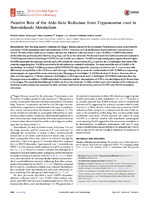Please use this identifier to cite or link to this item:
http://sgc.anlis.gob.ar/handle/123456789/1431| DC Field | Value | Language |
|---|---|---|
| dc.contributor.author | Garavaglia, Patricia A | es |
| dc.contributor.author | Laverrière, Marc | es |
| dc.contributor.author | Cannata, Joaquín J B | es |
| dc.contributor.author | García, Gabriela Andrea | es |
| dc.date.accessioned | 2019-12-04T19:10:25Z | - |
| dc.date.available | 2019-12-04T19:10:25Z | - |
| dc.date.issued | 2016-04-22 | - |
| dc.identifier.issn | 0066-4804 | - |
| dc.identifier.uri | http://sgc.anlis.gob.ar/handle/123456789/1431 | - |
| dc.description | Fil: Garavaglia, Patricia Andrea. ANLIS Dr.C.G.Malbrán. Instituto Nacional de Parasitología; Argentina. | es |
| dc.description | Fil: Cannata, Joaquín J B. Instituto de Investigaciones Biotecnológicas, Universidad Nacional de General San Martín-CONICET; Argentina. | es |
| dc.description | Fil: Laverriere, Marc. Instituto de Investigaciones Biotecnológicas, Universidad Nacional de General San Martín-CONICET; Argentina. | es |
| dc.description | Fil: Garcia, Gabriela Andrea. ANLIS Dr.C.G.Malbrán. Instituto Nacional de Parasitología; Argentina. | es |
| dc.description.abstract | Benznidazole (Bz), the drug used for treatment of Chagas' disease (caused by the protozoan Trypanosoma cruzi), is activated by a parasitic NADH-dependent type I nitroreductase (NTR I). However, several studies have shown that other enzymes are involved. The aim of this study was to evaluate whether the aldo-keto reductase from T. cruzi (TcAKR), a NADPH-dependent oxido-reductase previously described by our group, uses Bz as the substrate. We demonstrated that both recombinant and native TcAKR enzymes reduce Bz by using NADPH, but not NADH, as a cofactor. TcAKR-overexpressing epimastigotes showed higher NADPH-dependent Bz reductase activity and a 50% inhibitory concentration (IC50) value for Bz 1.8-fold higher than that of the controls, suggesting that TcAKR is involved in Bz detoxification instead of activation. To understand the role of TcAKR in Bz metabolism, we studied TcAKR expression and NADPH/NADH-dependent Bz reductase activities in two T. cruzi strains with differential susceptibility to Bz: CL Brener and Nicaragua. Taking into account the results obtained with TcAKR-overexpressing epimastigotes, we expected the more resistant strain, Nicaragua, to have higher TcAKR levels than CL Brener. However, the results were the opposite. CL Brener showed 2-fold higher TcAKR expression and 5.7-fold higher NADPH-Bz reduction than the Nicaragua strain. In addition, NADH-dependent Bz reductase activity, characteristic of NTR I, was also higher in CL Brener than in Nicaragua. We conclude that although TcAKR uses Bz as the substrate, TcAKR activity is not a determinant of Bz resistance in wild-type strains and may be overcome by other enzymes involved in Bz activation, such as NADPH- and NADH-dependent reductases. | es |
| dc.format | - | |
| dc.language.iso | en | es |
| dc.relation.ispartof | Antimicrobial agents and chemotherapy | es |
| dc.rights | Open Access | - |
| dc.rights | Creative Commons Attribution 4.0 International License | - |
| dc.rights.uri | http://creativecommons.org/licenses/by/4.0/ | - |
| dc.source | 2016; 60(5):2664-2670 | - |
| dc.subject | Trypanosoma cruzi | es |
| dc.subject | Enfermedad de Chagas | es |
| dc.title | Putative Role of the Aldo-Keto Reductase from Trypanosoma cruzi in Benznidazole Metabolism | es |
| dc.type | Artículo | es |
| dc.identifier.doi | 10.1128/AAC.02185-15 | - |
| anlis.essnrd | 1 | - |
| item.grantfulltext | open | - |
| item.cerifentitytype | Publications | - |
| item.fulltext | With Fulltext | - |
| item.openairecristype | http://purl.org/coar/resource_type/c_18cf | - |
| item.languageiso639-1 | en | - |
| item.openairetype | Artículo | - |
| Appears in Collections: | Publicaciones INP | |
Files in This Item:
| File | Description | Size | Format | |
|---|---|---|---|---|
| zac2664.pdf | Artículo en inglés | 708.89 kB | Adobe PDF |  View/Open |
Page view(s)
129
checked on Dec 2, 2025
Download(s)
28
checked on Dec 2, 2025
Google ScholarTM
Check
Altmetric
Altmetric
This item is licensed under a Creative Commons License


